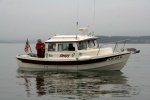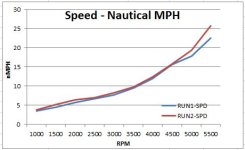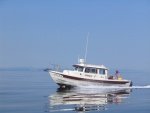seagrits@aol.com
New member
Fuel consumption....
Evening folks... just got back from a 3 day cruise on our 22. Total milage for the trip was 172 miles, and did some testing while out.
Twin 50 hp Hondas, carbureted
Rpm. Speed
2000. 7.1 mph
2500. 8.5 mph
3000. no data
3500. 13 mph
4000. 17.5 mph
4500. 20 mph
Using this sight for fuel consumption (granted they are now fuel injected) https://www.boat-fuel-economy.com/honda ... us-gallons
I calculated my fuel consumption and was quite surprised.
Rpm. Speed. Burn/hr(site) fuel economy
2000. 7.1 mph. .7. 10.14 mpg
2500. 8.5 mph. 1. 8.5 mpg
3000. no data. 1.3
3500. 13 mph. 1.5. 8.6 mph
4000. 17.5 mph. 1.6. 10.9 mpg
4500. 20 mph. 2.0. 10.0 mpg
Now the final tally would be devided by 2 because of twins, but I was amazed how ducking along at 7.1 mph gives comparable performance as 20 mph.
Are any of you experiencing similar numbers?
Many thanks.
Evening folks... just got back from a 3 day cruise on our 22. Total milage for the trip was 172 miles, and did some testing while out.
Twin 50 hp Hondas, carbureted
Rpm. Speed
2000. 7.1 mph
2500. 8.5 mph
3000. no data
3500. 13 mph
4000. 17.5 mph
4500. 20 mph
Using this sight for fuel consumption (granted they are now fuel injected) https://www.boat-fuel-economy.com/honda ... us-gallons
I calculated my fuel consumption and was quite surprised.
Rpm. Speed. Burn/hr(site) fuel economy
2000. 7.1 mph. .7. 10.14 mpg
2500. 8.5 mph. 1. 8.5 mpg
3000. no data. 1.3
3500. 13 mph. 1.5. 8.6 mph
4000. 17.5 mph. 1.6. 10.9 mpg
4500. 20 mph. 2.0. 10.0 mpg
Now the final tally would be devided by 2 because of twins, but I was amazed how ducking along at 7.1 mph gives comparable performance as 20 mph.
Are any of you experiencing similar numbers?
Many thanks.




